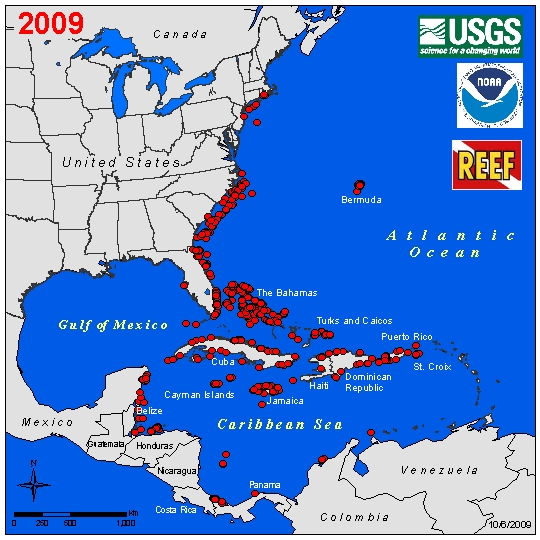RickI
Contributor
I was over diving off Nassau recently when the dive master related the often told, "Hurricane Andrew's 15 ft.+ storm surge that gently freed 6 or so lionfish to populate the Bahamas, Bermuda, Turks & Caicos much of the eastern seaboard ..." Well, let's think about this for a second. Where have lionfish been the most rare to date from all these areas? SE Florida. That seems to be changing, slowly, I've yet to see one here but am reading reports of them here.
I see a lot every time I'm in the Bahamas, far more than I ever saw in their native haunts during a trip to the Red Sea by the way.
So, you apparently have the fewest lionfish at the proported point of origin 17 years ago. Then you have the daunting task of surviving a devastating storm surge and reportedly being seen in local waters within a week. As I recall, things were silted out for sometime near the shore particularly in the carbonate silts down that way.
So where did they come from? Got me, good guess is we had something to do with it though. The ship bilge water theory provides a ready mechanism and yet, ships have been spewing ballast water for a very long time and the earliest reports of lionfish sightings I've heard of date back about 20 years, usually sooner than that. Some have mentioned aquaculture operations inadvertently releasing fertilized eggs, fry through raw water tank discharge in the Bahamas. The fry may spend sometime beneath sargassum mats floating with prevailing currents (e.g. Gulfstream) to aid distribution. The suggestion of releases by home aquarists has some credibility, For comparison, look at the python problem in southern states, no way those monsters slipped out of air cargo or ship bilges. Some irresponsible fools let their babies out to prey upon the world, local ecology and the odd child because ... rampant stupidity, short sightedness. Got me again.
Bottom line, the lionfish are here and in some areas are extremely common. Can reason what likely impacts might be and yet still on the fence to see if that is what comes about. Not crazy about spearfishing, resource depletion goes way back, and yet, support an exception in this case. Supposed to taste better than hogfish, have at it, don't get stung.
I see a lot every time I'm in the Bahamas, far more than I ever saw in their native haunts during a trip to the Red Sea by the way.
So, you apparently have the fewest lionfish at the proported point of origin 17 years ago. Then you have the daunting task of surviving a devastating storm surge and reportedly being seen in local waters within a week. As I recall, things were silted out for sometime near the shore particularly in the carbonate silts down that way.
So where did they come from? Got me, good guess is we had something to do with it though. The ship bilge water theory provides a ready mechanism and yet, ships have been spewing ballast water for a very long time and the earliest reports of lionfish sightings I've heard of date back about 20 years, usually sooner than that. Some have mentioned aquaculture operations inadvertently releasing fertilized eggs, fry through raw water tank discharge in the Bahamas. The fry may spend sometime beneath sargassum mats floating with prevailing currents (e.g. Gulfstream) to aid distribution. The suggestion of releases by home aquarists has some credibility, For comparison, look at the python problem in southern states, no way those monsters slipped out of air cargo or ship bilges. Some irresponsible fools let their babies out to prey upon the world, local ecology and the odd child because ... rampant stupidity, short sightedness. Got me again.
Bottom line, the lionfish are here and in some areas are extremely common. Can reason what likely impacts might be and yet still on the fence to see if that is what comes about. Not crazy about spearfishing, resource depletion goes way back, and yet, support an exception in this case. Supposed to taste better than hogfish, have at it, don't get stung.






